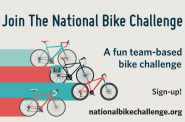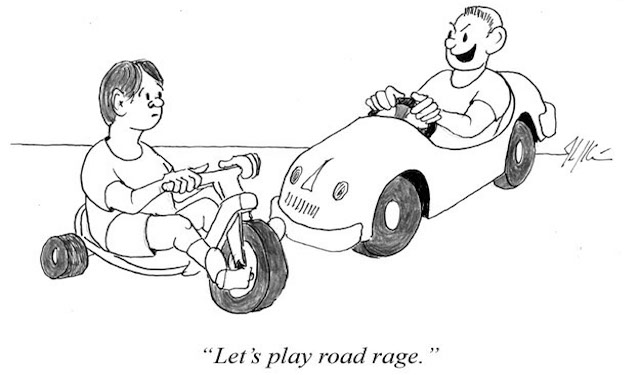Get Out of the Road!
Why do automobile drivers yell at legal bikers and pedestrians? Probing this ugly form of road rage.
I’m just coming down from all the love I get riding around on the Santa Cycle Rampage, so it has been particularly distressing to be the victim of rage several times recently. In each incident, the angry person behind the wheel screamed for me to get out of the road and honked.
The next two incidents occurred while I was walking in marked crosswalks. Neither driver even had to stop, just slow a few miles per hour to yield the right of way. The second time I was told to get out of the road, it happened in a crosswalk with one of those bright yellow in-street sign that says, “State Law: Yield to Pedestrian In A Crosswalk.” I just pointed at the sign and stepped onto the curb, but the driver still honked again as he was driving away.
As the vintage cartoon below indicates, road rage is nothing new. People have been getting angry when they get behind the wheel for about as long as there have been motor vehicles.
You might chalk it up to seasonal affective disorder. I’ve always figured road ragers tend to be angry in the car or out, but a recent study published in the journal of Transportation Research Part F: Traffic Psycohology and Behaviour found that instead, there might just be something about being in a car that actually makes some people angry or feel more free to express anger.
The study showed some positive connection between anger in general and road rage, but also showed that just because someone tends to flip out if they are stuck in traffic, doesn’t mean they will yell at you if you take too long in the line at the bank teller or forget something and make them wait at the grocery check-out.
Other studies have indicated that people feel a certain cloak of anonymity when driving that frees them to express their anger. I think this is kind of like anonymous comments on the internet.
At the Bike Fed, we don’t get angry, we educate and encourage. Thanks to our Share & Be Aware program, we are able to go to the state Drivers Education Instructors Convention each year, provide curriculum about pedestrian and bicycle laws and encourage them to include it in their classes. The Share & Be Aware program also allows us to get billboards and PSAs out that reach millions of people.
Crash rates have been dropping for a couple decades now, and we hope our efforts play a part in that downward trend, but one has to wonder if there is just something about getting behind the wheel that turns people into rageaholics. Maybe the Bike Fed should teach people to wear Santa suits when they ride. The Santa Cycle Rampage is about the only time I know that everyone who honks at me is happy to see me on the road.
This story was originally published by the Bicycle Federation of Wisconsin.
Bike Czar
-
Join a Bike Ride Under the Polish Moon
 Jun 1st, 2018 by Dave Schlabowske
Jun 1st, 2018 by Dave Schlabowske
-
9 Reasons to Join National Bike Challenge
 May 4th, 2018 by Dave Schlabowske
May 4th, 2018 by Dave Schlabowske
-
Biking Through the Mindoro Cut
 Apr 27th, 2018 by Dave Schlabowske
Apr 27th, 2018 by Dave Schlabowske





















I guess when I find out you are paying taxes for the upkeep of the roads I will treat you as an equal. Until then you can get out of the way.
Really Rafe? How do you think local roads get paid for?
Rafe, gas taxes don’t fund the costs of local roads. Why do you think property taxes are so high?
Milwaukee is the only city where I’ve seen drivers honk at peds crossing in the cross walk with a walk signal. I have a walking commute every day and it’s scary the lack of regard drivers pay to everyone else. I don’t have any data to back up this assertion, but Milwaukee *feels* less safe for pedestrians than other big cities in the US.
I wonder if it’s related to density. Where it’s high enough that there are a lot of people forced to interact on the street, but not enough peds or ped infrastructure for drivers to take caution.
Dave, you’re spot on with the idea that people are more likely to vent their rage when in a car vs when not in their car. I think though you miss another major piece of the puzzle. I believe people’s ignorance plays just as important a role. Many people don’t know the laws of the road regarding bikes and pedestrians. I’ll admit, before I started biking I was pretty ignorant myself of both the laws and the courtesies. I remember one time I yelled at bikers for riding two wide down a single lane of road in a construction zone. All I saw was that they were blocking traffic, not that it’d be dangerous for cars to pass the single riders. If I could go back and slap the younger version of myself I would.
The other day I saw a guy riding his bike on Highway 100 going northbound by Mayfair as the daylight was winding down. Extremely busy time of day and he wasn’t easy to see. I get that he had a right to be doing that and therefore didn’t roll down the window and yell at him, but I wondered if that was really a great place to be riding a bike with all that traffic. As a biker myself I’d like to see my fellow cyclists use a little better judgment on where they ride at times.
People as a whole are more discourteous and into their own little world than they’ve ever been. They are generally rude everywhere, so I don’t think cyclists and pedestrians are really being singled out. They just happen to be in the way of people who think they are really important.
A comprehensive program of educating the public about the rules of the road that cover vehicles/pedestrians and vehicles/bicycles could be very fruitful. Increased enforcement of existing laws and municipal ordinances should follow the program. PSAs are a useful tool for efforts like this.
There are certainly scenarios in which bicyclists and pedestrians make stupid decisions, whether they are technically following the law or within grey area circumstances.
Sometimes common sense needs to be used by those NOT in a car to avoid tempting fate …even if you ARE technically abiding by the law. Example: If you want to bike on Water Street or other busy roads, by all means do it. BUT, if you are a daredevil who like to ride while weaving through heavy traffic and leaving just inches of space between your lower limbs and 2-ton trucks/SUV’s driven by inattentive people (admit it – we’re ALL inattentive at times in this day and age) …then your odds of eventually getting flattened are not in your favor.
In these cases, what is just, right and legal means nothing ….the bottom line is pride, animosity and invincibility complexes lead to bloody pavement and broken bicyclists. The CARS never lose, even if the driver happens to be an idiot.
Dave, I think that has happened to all of us cyclists at one time or another. I agree with you about bicycle education. It should be part of drivers ed as a start so people are better aware of how to ride a bike properly on the road and how to drive a car with cyclist’s rights and safety in mind. Not sure what to say to someone like Rafe. Too many out there like him/her…
Rafe, freeways in many built-up areas now cost around $12 million per lane mile to build. That’s almost $200 million for ONE MILE of a freeway like the 405, which is sixteen lanes wide in some places. Then there’s maintenance, which goes on forever. (By contrast, a two-lane bikeway costs a few thousand per mile to build, lasts for years and is cheap to repair.) In California, auto and gas sales taxes and license fees pay for less than a third of the cost of roads. The rest is paid by general revenues, like sales taxes, into which cyclists pay just like everyone else. BTW, the right of cyclists to use the public roads is now the law in every state in the country. We have exactly the same right to the road as you do.
Driving in a car and yelling out the window at bikers and pedestrians is no different than commenting anonymously to an online forum. You can scream your derogatory head off and then simply drive away and none of your peers will know anything about it. So Rafe up their is just one of those on-line trolls who feels better about himself by venting in an idiotic manner but doesn’t have to worry about their close friends knowing what a d*ck they are.
It is the same with the “perceived” bit of safety. People don’t want a bicyclist on HWY 100 because “the biker is hard to see”. Not knowing the circumstances, it is possible either or both at fault (due to not having lights on, etc). But, the fact of the matter is, a bicyclist is a vehicle per state law and has the same right to be there as the car. And the bike can get ticketed for going on to the sidewalk. A biker is just like a car driver, taking the shortest and fastest path home, give them some room.
And don’t even get me started on that BS of “bikers don’t pay for roads.” You really are showing your ignorance with that statement.
When I lived in Milwaukee, I rode my bike quite a bit but never got yelled at by a motorist. I’m assuming, however, they were just yelling in at me with their windows up. As for pedestrians crossing the street, why not just step up enforcement, especially for when cars don’t yield to pedestrians crossing or stop far beyond the ‘stop line.’ Here in Spain, where I live now, cars legally have to stop for pedestrians entering the crosswalk, and it’s highly emphasized in driver’s education courses. If I put one foot in a crosswalk, 99% of the time cars stop and let me cross.
Rory, Milwaukee is one of the safest — and densest — big cities in the country. Milwaukee ranked 11th safest for pedestrians out of 51 large metro areas, as cited in “Dangerous by Design 2014” by Smart Growth America. And the four-county metro area ranked 15th in population density among the top 102 metros, according to the U.S. Census Bureau.
What amazes me are the people who walk in front of moving traffic without even looking. Yes, they’re in a crosswalk, but they’re abusing the law — and asking to get hit — by assuming drivers will (or can) stop for them in time. I live downtown, and I can’t tell you how many times this has happened when I’m 1/4 block away from the pedestrian. They’re only leaving a split second for drivers to slam on the brakes. I walk all the time, but I try to be responsible and reasonable when crossing streets.
The day cyclists start to obey the traffic laws en mass is the day I’ll have sympathy for your plight.
So “Andy,” you’re ok with people yelling at others, even if that person is obeying the law, just because others might not be? I’d imagine that me yelling at you for speeding, even if you’re going the speed limit, would make me look pretty ridiculous.
I’d say that the large number of bicyclists that disregard traffic laws is of greater concern than the hurt feelings of the author caused by some jerk he’ll likely never see again.
@Jeff how fast are you going on city streets that you find it difficult to stop in a 1/4 block?
Both motorists and bicyclists routinely violate and disregard traffic laws, it’s just that they tend to be different laws.
Motorists ought to bear a greater responsibility as the operators of large, heavy, and fast equipment that may be extremely dangerous to others.
Hereiam, as a city block is usually defined as 100 meters, a 1/4 block would be 25 meters. A car in good working order until ideal conditions will (on average) stop in 23 meters at 30 mph. Any faster than that (or any snow/slush/rain on the ground), and you’d probably find it difficult to stop in 1/4 block.
http://www.drivingtesttips.biz/stopping-distances.html
@Kyle given that the speed limit on city streets is 30 mph, according to your chart it is reasonable to expect drivers to be able to stop in 1/4 block.
Also, that chart gives a pretty conservative estimate of stopping distances. For example, it says that if you are traveling 30 mph in snow it will take 149 meters (1 1/2 blocks) to stop.
Perhaps those numbers are conservative. I didn’t look for multiple sources for them. They also build in an average perception-reaction time, which could be why you think they’re high.
That being said, depending upon where said pedestrian is crossing, they need to either allow for a reasonable break in traffic, or yield to all vehicles. In Jeff’s example, odds are pretty good the pedestrian is actually in the wrong.
Okay, now for a wall of text to support that (http://www.dot.wisconsin.gov/safety/motorist/pedestrians/docs/pedlaws.pdf):
346.24: Crossing at uncontrolled intersection or crosswalk.
(1) At an intersection or crosswalk where traffic is not controlled by traffic control signals or by a traffic officer, the
operator of a vehicle shall yield the right-of-way to a pedestrian, or to a person riding a bicycle or electric personal
assistive mobility device in a manner which is consistent with the safe use of the crosswalk by pedestrians, who is
crossing the highway within a marked or unmarked crosswalk.
(2) No pedestrian, bicyclist, or rider of an electric personal assistive mobility device shall suddenly leave a curb or
other place of safety and walk, run, or ride into the path of a vehicle which is so close that it is difficult for the
operator of the vehicle to yield.
(3) Whenever any vehicle is stopped at an intersection or crosswalk to permit a pedestrian, bicyclist, or rider of an
electric personal assistive mobility device to cross the roadway, the operator of any other vehicle approaching from
the rear shall not overtake and pass the stopped vehicle.
346.25: Crossing at place other than crosswalk
Every pedestrian, bicyclist, or rider of an electric personal assistive mobility device crossing a roadway at any point
other than within a marked or unmarked crosswalk shall yield the right-of-way to all vehicles upon the roadway.
I apologize for that awful formatting. It did not appear that way in the comment box.
@Kyle can I ask why you think the pedestrian is in the wrong in the situation @Jeff describes?
We agree the estimates is on the conservative side, but still holds that a driver should be able to see a pedestrian, react and stop his or her vehicle within 23 meters. As you noted, 1/4 of a standard city block is 25 meters. The pedestrian stepping off the curb at 1/4 mi is fully compliant, even assuming the street is a 30mph zone and that the driver’s view of the crosswalk is obstructed by a parked car.
The WI statute is horribly deferential to drivers, but I would be interested to know what % of drivers comply with the statute as written.
Under ideal conditions, roughly 50% of cars in good condition should be capable of stopping within 6 feet of the pedestrian, and you don’t think that qualifies as difficult to yield? Good luck at night in January on Brady Street…
Keep in mind, this isn’t at a traffic light. I’m assuming Jeff wasn’t racing through red lights. In a crosswalk, the pedestrian gets the right of way, but you don’t get to just step into traffic. Seems reasonable (if unenforceable). Jaywalkers have to yield to everyone, but good luck with that on Brady or near either campus.